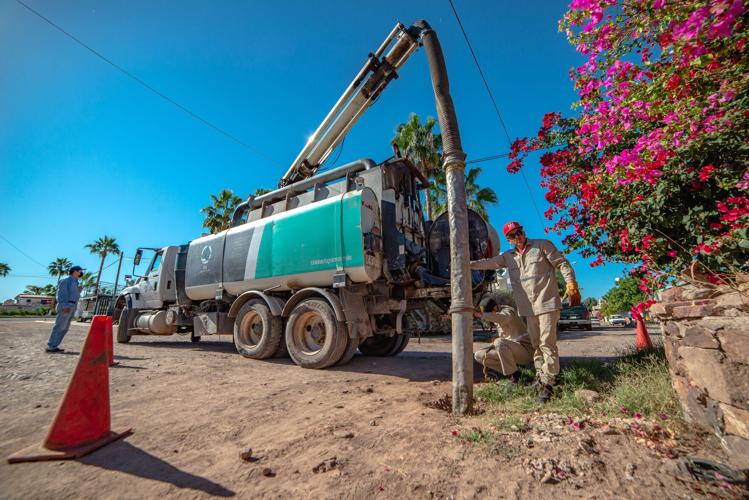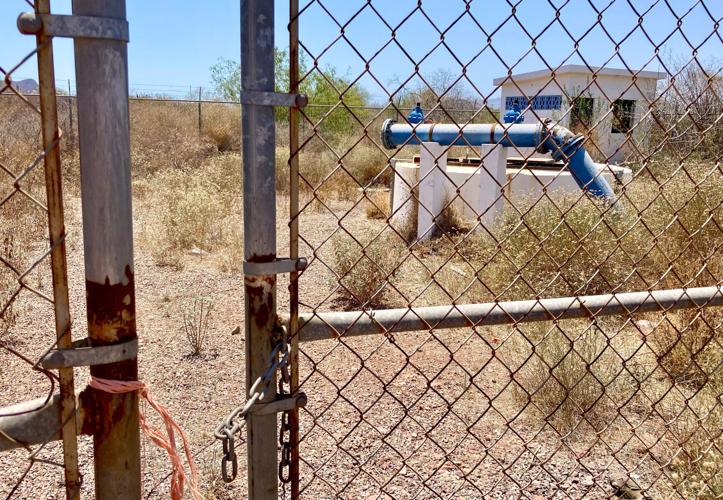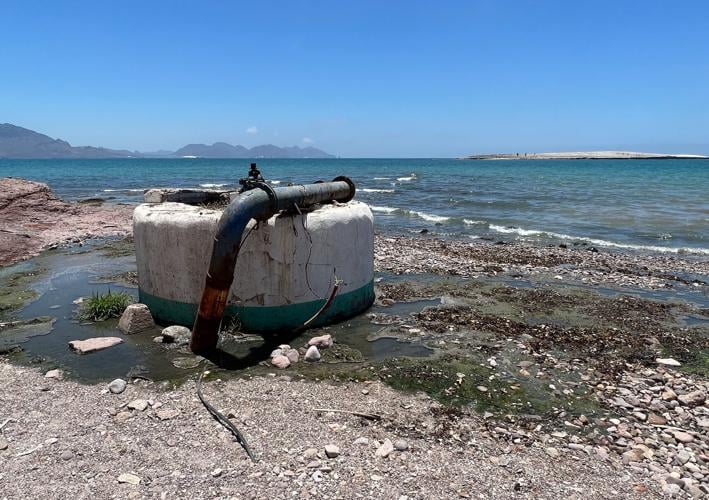GUAYMAS, SONORA — As sewage spills continue to plague the port city of Guaymas and its tourist sector of San Carlos, local officials are touting new projects to help resolve the decades-old problem.
But many residents, health experts and tourists are frustrated at the slow pace of progress.
Sierra Vista resident Michael Palm said the worsening sewage situation led his family to cancel their regular trip to San Carlos this summer and instead head to San Diego.
Palm said his family usually visits San Carlos a few times a year. His 8-year-old son loves snorkeling in the Sea of Cortes, and Puerto Peñasco, Sonora, can’t compete with San Carlos’ small-town atmosphere and its majestic mountains that reach the edge of the sea, he said.
But during their last visit, in December, the odors were hard to ignore, he said.
“It just became too much for us,” said Palm, a custom log-furniture craftsman. “One of our favorite taco places has just been engulfed with the overwhelming stench of sewage, so bad you can even smell it while dining inside. … It’s quite a disappointing situation happening down there.”
This month Guaymas mayor Karla Córdova announced five public works projects focused on water infrastructure, including new sewer pipes in the Guaymas Centro, where sewage back-ups sometimes inundate heavily trafficked roadways, as well as the Mar de Cortes and Villas de Miramar sectors of the city.

Guaymas Norte resident Guadalupe García said a large sewage leak has been ongoing on the road in front of her home for about 18 months, despite repeated reports to the water and sewer company, known as CEA.
The only project announced for San Carlos — which has experienced a massive tourism boom during the pandemic — adds potable water pipes and a storage tank in the Los Algodones sector, addressing another major concern: widespread potable water leaks amid a long-running drought.
In a June 10 press conference, Córdova, who took office in September, acknowledged the frustration of residents who have dealt with a failing sewer system, and unfulfilled promises for reform, for decades.
Some are angry her administration hasn’t done more in its first nine months in office. Córdova attributed delays to bureaucratic processes that must be completed before securing funding.
Funding will come from the local, state and federal levels, she said.
“We know that as time goes on, we are losing the trust of the people,” Córdova said in Spanish during the press conference. “That’s why we’re explaining to you why the problem hasn’t been solved. We want all Guaymas citizens to feel secure knowing the three levels of government are working for their well-being.”
The plan also calls for a new wastewater stabilization lagoon in the Yaqui community of Vicam. All five projects must be completed by the end of this year, Córdova said.
Not enough
Environmental health experts and Guaymas residents say more urgency is needed to tackle the escalating sewage problem.
The recently announced projects are a modest start, said Jaqueline García Hernández, a biochemical engineer who runs the Environmental Sciences Lab at CIAD in Guaymas, which is part of a network of federally supported laboratories.
“It’s not nearly enough,” she said.
García Hernández is leading a team of researchers in an experiment that aims to improve the city’s overwhelmed oxidation lagoon, known as La Salada. Oxidation lagoons treat wastewater naturally through the combination of sunlight, oxygen, algae and bacteria.
Ultimately, experts say modern wastewater treatment plants will be necessary in Guaymas and San Carlos. The oxidation lagoons are insufficient to handle the volume of waste generated by the growing population, according to former directors of the Comisión Estatal del Agua, known as CEA.
CEA is the state agency that administers Guaymas’ potable water and sewer systems.
On Tuesday, the Arizona Daily Star submitted a list of questions for Córdova regarding the city’s progress so far in dealing with the sewage crisis. A mayor’s office spokesperson initially agreed to send more details on the new projects and to forward the Star’s questions to the mayor.
But after the initial exchange, neither the spokesperson, nor the mayor, replied to the Star’s messages.
Environmental damage
Last November, state officials declared a health emergency in Guaymas and allocated $10 million pesos — about $490,000 dollars — in emergency funding as sewage leaks overran the city.
In December the Star published a four-month investigation exploring the root causes of, and realistic solutions to, the sewage crisis in Guaymas and San Carlos. A collaboration with KJZZ’s Fronteras Desk, the project was funded by the Pulitzer Center on Crisis Reporting.
Sewage spills impact not only human health, but environmental health as well.
Retirees Dave and Sue Barlow of Utah spend about half the year in San Carlos, where they own a seaside home on San Francisco Beach.
For about six weeks this spring, a sewage pump station near their home spilled waste onto the beach and into the sea, Dave Barlow said.
“The smell is bad enough, but we’re worried about kids and people swimming in the water along with the damage it’s doing to the ocean,” he said on May 24.

For six weeks this spring, sewage poured from a broken pump station on San Francisco beach in San Carlos. “The smell is bad enough, but we’re worried about kids and people swimming in the water along with the damage it’s doing to the ocean,” said Dave Barlow, who lives nearby the leak. Barlow said he had to make three trips to the CEA office before it was finally fixed at the end of May. While the fix came as a relief, Barlow is still concerned: CEA workers told him they were replacing the pump with an older, used one. “I hope it doesn’t break again,” he said.
Barlow said he had to make multiple trips to the CEA office before the broken pump was finally replaced. While the fix came as a relief, Barlow is still concerned: CEA workers told him they were replacing the pump with an older, used one.
“I hope it doesn’t break again,” he said.
Not an easy fix
The Twitter page of CEA’s regional Guaymas office is filled with reports of its ongoing repairs to the sewage and potable water systems in Guaymas and San Carlos.
But CEA workers are facing an uphill battle. Former CEA regional director Ivan Cruz said last fall that Guaymas’ sewer system has the “perfect storm” of challenges. That includes hilly topography that requires enormous amounts of energy to pump sewage, rocky soil that can easily damage poorly installed pipes, and inadequate resources, exacerbated by frustrated residents who don’t pay their water bills.
While some are calling for an increase in Guaymas’ water rate to generate more funds, Córdova emphasized in the press conference she is committed to resolving the sewage problem before imposing higher tariffs on citizens.
Another challenge emerged this month: CEA Guaymas regional director, David Pintor, submitted his resignation after eight months on the job.
Pintor did not respond to the Star’s request for comment on his departure.
Sonoran Gov. Alfonso Durazo, who took office in September, campaigned on a promise to modernize the historic port city of Guaymas — an economic driver for the state — and he’s voiced his commitment to fixing the sewage crisis there.
The Star also submitted questions to the state’s communications office on Tuesday, seeking more details on the proposed projects and progress so far in improving Guaymas’ sewage infrastructure.
On Friday, a spokesman said both Gov. Durazo’s office, and the state-level office of the Comisión Estatal del Agua, declined to comment.
Seeking solutions
In the days after the Star’s investigative series was published, beginning on Dec. 5, state officials highlighted plans to tackle the problem.
On Dec. 6, Sonora’s infrastructure department posted a video on Twitter, explaining Guaymas’ sewage crisis and describing plans for six new sewage pumps in the city.
“We are already working to create a solution,” Durazo said on Dec. 8 when asked about the Star’s coverage. “We are aware that there is a historic issue, that the drainage system is obsolete. We can’t nor do we want to hide that. But in our concern, we’ve already asked the president for support to build a solution given the urgency of the situation.”
The Mexican government has committed $5 billion pesos — about $240 million dollars — to port modernization projects in Sonora, including upgrading the sewage system in Guaymas. Among the projects: Construction of an additional oxidation lagoon in North Guaymas and eventually, a wastewater treatment plant.
CEA Sonora director José Luis Jardines said in a Dec. 9 press release that $256 million pesos, (about $12 million dollars) had been allocated to Guaymas infrastructure upgrades over the next three years, plus $100 million pesos (about $4.9 million dollars) from the Guaymas port authority, known as Apiguay, will be dedicated to fixing the city’s sewage and potable water systems.
He described plans to construct a pluvial drainage system, to prevent rainwater filled with debris from flooding the sewer system, as well as the rehabilitation of aging sewage pumps and installation of back-up pumps in case of a pump failure.
Beach spill
Last month in Miramar, a high-end neighborhood in Guaymas, a waterfall of sewage poured onto one of the city’s most popular beaches, before flowing into a bay of the Sea of Cortes. The spill originated from an overflowing manhole cover up the road, outside a large residential development.
Within hours, CEA workers halted the leak after a public outcry and a series of social media posts on the environmental hazard. CEA later reported the sewage flow was caused by a clamp, in a state of deterioration, becoming detached from a pressurized sewage line.
It was a notably quick response. Guaymas residents report waiting weeks or months for urgently needed repairs, which often end up being short-term fixes.
In the densely populated Guaymas Norte — the fastest growing part of the city — some residents say they feel abandoned by CEA.
Last week Guadalupe García, 29, was waiting for the bus with her 3-year-old daughter and 10-year-old son. A few meters away, sewage audibly gurgled up from a manhole cover before flowing down the road.

Guadalupe García, 29, and her 3-year-old daughter Sofia stand in front of their Guaymas Norte home on June 15. García said a large sewage leak has been ongoing on the road in front of her home for about 18 months, despite repeated reports to the water and sewer company, known as CEA. The smell is especially sickening at night, when more people are home from work, making it impossible to open the windows or be outside, García said.
Despite repeated reports to CEA, the sewage leak has been ongoing for a year and a half, García said.
Her family can smell the sewage from inside their home just up the road, she said.
“At night, it smells horrible,” she said in Spanish. “You can’t leave the window open or anything because it smells a lot. Even with the air conditioning on, the smell comes in.”
García and her neighbors — some of whom have been sickened by sewage exposure — are organizing to demand action, she said.
A possible explanation for the ongoing sewage flow appeared to be an unsecured and out-of-service sewage pump station near García’s house.
The station houses sewage pumps intended to move wastewater to the city’s oxidation lagoon on the south side of Guaymas. Last week, the chain-link fence around the pump station was unlocked, and there was no sound coming from the equipment. All electrical cords appeared to have been cut and removed.

An out-of-service sewage pump appears to be the reason for an ongoing sewage leak on the northern outskirts of Guaymas Norte. Last week, the chain-link fence around the pump station was unlocked, and there was no sound coming from the equipment. All electrical cords appeared to have been cut and removed. Guaymas Mayor Karla Córdova has acknowledged the need for greater security around sewer equipment, which is often burglarized.
Former CEA leaders have highlighted the need for greater security around sewer equipment, which is often burglarized and vandalized. Dozens of manhole covers are also missing throughout Guaymas, resulting in trash and debris flowing into the system and clogging sewer pipes.
Guaymas Cómo Vamos
Some Guaymas residents are taking proactive steps themselves.
A citizen-led initiative, “Guaymas Cómo Vamos,” seeks to identify, study and develop realistic solutions to the city’s major challenges.
Guaymas’ sewage crisis is at the top of their priority list.
The non-governmental organization has gathered a team of stakeholders from various sectors, including civil engineers, health experts and environmental scientists.
At a Wednesday meeting, participants brainstormed causes of the sewage crisis, including a lack of technical training and supervision for CEA workers, resulting in poor workmanship that doesn’t hold up over time.
Other issues raised included the lack of transparency from CEA and the lack of maintenance of existing infrastructure.
Sociologist Rogelio Velázquez Camarena, who is the founder of Guaymas Cómo Vamos, said many Guaymas residents have resigned themselves to substandard living conditions and have little hope for change.
But Velázquez, 38, said he’s an optimist. He believes the citizen-led group, drawing on the expertise of its participants, will drive progress and improve the quality of life for residents.
“I am totally convinced,” he said. “There are many people who tell me that it can’t be done. What I have told them: You are not going to convince me that it is not possible. I want to convince you that it is.”









